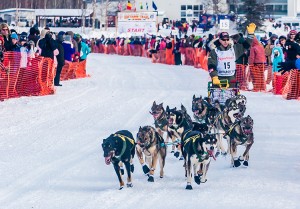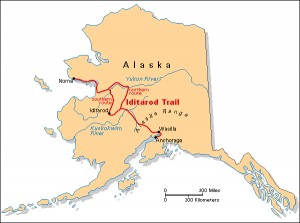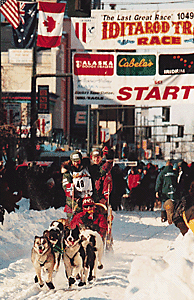Iditarod 2020
Monday, March 23rd, 2020March 23, 2020
Last week, on March 18, the Norwegian musher (sled driver) Thomas Waerner won the annual Iditarod Trail Sled Dog Race in Alaska. The Iditarod is the world’s most famous sled dog race. The roughly 1,000-mile (1,600-kilometer) race starts on the first Saturday of March in Anchorage and ends in Nome. Waerner won his first Iditarod in just his second try. His only previous race had been a 17th place finish in 2015. The Iditarod, which began this year on March 7, was one of the few sporting events not cancelled or otherwise effected by the ongoing COVID-19 pandemic.

The Iditarod is a famous sled dog race held every March in Alaska. Teams of sled dogs race between Anchorage and Nome. Credit: © Shutterstock
Waerner’s winning race time was 9 days, 10 hours, 37 minutes, and 47 seconds—nearly 6 hours ahead of the second-place finisher, Alaska’s Mitch Seavey, a three-time Iditarod champion (2004, 2013, and 2017). Jessie Royer of Fairbanks, Alaska, finished third for the second-straight year, bringing her dog team in an hour and half after Seavey. Of the 57 mushers who began the race, 40 were able to complete the grueling course.
The Iditarod crosses the Alaska and Kuskokwim mountain ranges, heading northwest across the state and then north along the Bering Sea coast to Nome. The race follows a northern route in even years and a southern route in odd-numbered years. The Iditarod requires enormous endurance, both from the musher and the dogs. The race follows icy, snowy trails and typically takes about 10 to 17 days. Mushers and their dogs may train all year for the race.

Click to view larger image
The Iditarod race begins in Anchorage, Alaska. It crosses the Alaska and Kuskowim mountain ranges, heading northwest across the state and then north along the Bering Sea coast to the finish line in Nome. The race follows a northern route in even years and a southern route in odd-numbered years. Credit: WORLD BOOK map
Each musher begins the race with between 12 and 16 dogs. At least 5 dogs must finish. (Waerner and Seavey both finished with 10 dogs running, and Royer finished with 12.) The dogs, usually Siberian or Alaskan huskies, are selected for speed, endurance, and courage. The sled is extremely light, but it must be strong enough to carry the weight of the musher, equipment and provisions for the race, and sick or exhausted dogs.
The current Iditarod format originated in 1973, developing from shorter sled dog races first held in 1967 and 1969. It is held on the Iditarod Trail, a dog sled mail route first used in 1910. The race also commemorates an emergency rescue mission by dog sled to get medical supplies to Nome during a diphtheria outbreak in 1925. Balto, the lead sled dog in the final leg of that mission, became a popular canine celebrity.



